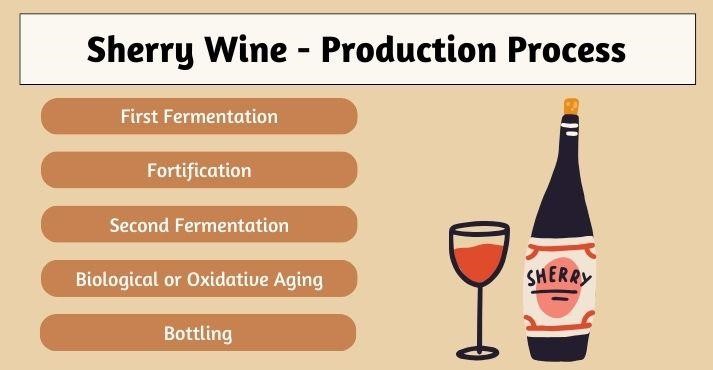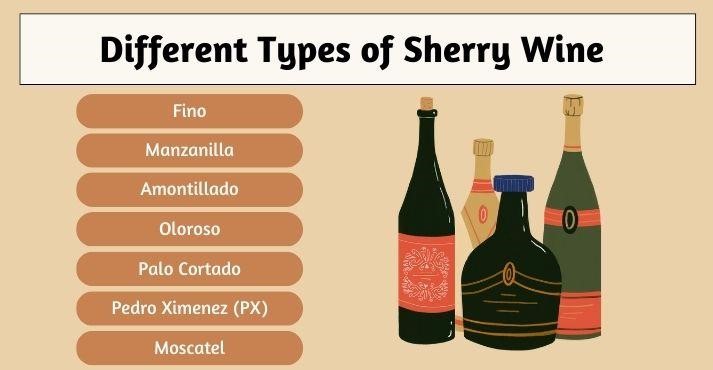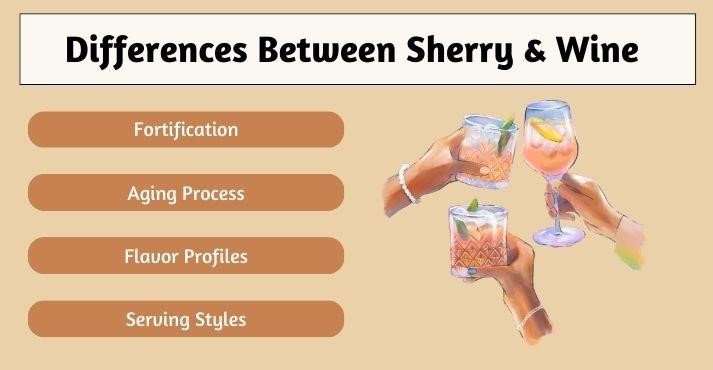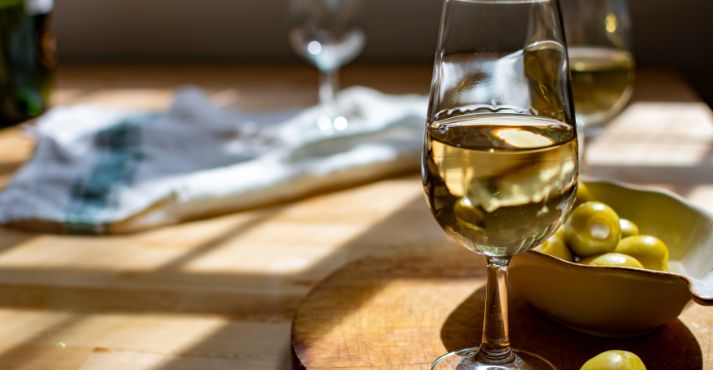Have you ever wondered what makes Sherry so distinctive? Unlike most wines, Sherry wine undergoes a unique aging and fortification process, giving it a rich, complex flavor profile.
With roots tracing back over a thousand years in Spain’s Jerez region, Sherry wine is unique in historical and modern cultures. Over the centuries, this sherry liquor has evolved, becoming a beloved choice for fine dining and even experimental cocktails.
Known for its versatility, Sherry alcohol is enjoyed in many forms, from light and dry to intensely sweet.
What is Sherry Wine?
Sherry is a fortified natural wine produced exclusively in the Jerez region of southern Spain. It is made by fermenting white grapes, particularly Palomino, Pedro Ximénez, and Moscatel, fortifying the resulting wine with grape spirit.
This fortification process, combined with Jerez’s unique climate and the traditional aging method known as the Solera system, gives Sherry its distinctive characteristics.
Unlike most wines, Sherry alcohol undergoes fortification, which involves adding distilled grape spirit to the wine.
This process raises the wine’s alcohol content and can result in different sweetness levels, depending on the type of Sherry produced. It can be light and dry or rich and sweet; Sherry offers various flavors to suit various palates.
How is Sherry Made?
The production of Sherry wine sets it apart from other types of wine. Its complex fermentation, fortification, and aging method in the Solera system results in various flavors and styles, from light and dry to rich and sweet.
Each step in the production process plays a crucial role in creating the unique characteristics of Sherry liquor. Let’s explore how this iconic wine is made.
Grapes Used
Sherry is produced using three primary grape varieties, each contributing to the distinct styles of the wine:
- Palomino is the most common grape for dry sherries like fino and oloroso. Due to their ability to thrive in the hot, dry climate, Palomino grapes are grown extensively in the Jerez region. Wines made from Palomino are typically light and dry, forming the backbone of most Sherry types.
- Pedro Ximenez (PX): Known for its high sugar content, the Pedro Ximenez grape is used to create the sweetest types of Sherry, such as PX dessert wines. The grapes are often sun-dried to concentrate their sugars before fermentation, resulting in a dark, syrupy wine with rich flavors of dried fruit and molasses.
- Moscatel: This grape variety produces sweeter, fruity Berries, similar to PX but with a lighter, more floral profile. Moscatel Sherry offers delicate sweetness and is often enjoyed as a dessert wine.
Production Process

The process of making Sherry wine begins with the fermentation of grape juice, much like any other wine. However, Sherry undergoes a unique process called double fermentation.
- First fermentation: The grapes are pressed, and the juice is fermented, converting the sugars into alcohol. At this stage, the wine is typically light and dry.
- Fortification: Once the initial fermentation is complete, the wine is fortified with a distilled grape spirit (brandy). This process increases the alcohol content to between 15% and 18%, depending on the Sherry’s production type. The fortification level determines the future aging process, influencing whether the wine will undergo biological or oxidative aging.
- Second fermentation: After fortification, the wine undergoes a second fermentation, stabilizing it and preparing it for aging. The choice of aging method (biological or oxidative) will significantly impact the final flavor and character of the Sherry.
After fortification, the wine is classified for one of two aging processes:
- Biological aging: The wine is aged under a layer of yeast called flor, which forms naturally on the surface of the wine. This yeast protects the wine from oxidation and imparts unique flavors, such as fresh, nutty notes. Fino and Manzanilla are examples of Sherries that undergo biological aging.
- Oxidative aging: Wines not protected by flor undergo oxidative aging, exposing them to oxygen during maturation. This exposure darkens the wine and develops more robust, complex flavors like caramel, dried fruits, and roasted nuts.
Aging and Maturation
A key factor distinguishing Sherry wine from other wines is the use of the Solera system, a traditional aging method that creates consistent quality across different vintages.
- Solera system: The Solera system involves a series of stacked barrels (called criaderas), each containing wine of varying ages. The oldest wine is stored in the bottom row, while the youngest is at the top. When wine is drawn from the bottom barrels for bottling, it is replenished with wine from the row above, ensuring each bottle contains a blend of wines from multiple years.
This fractional blending process not only passes on complexity but also ensures that Sherry liquor remains consistent in flavor and quality over time.
The Solera system allows older wines to continually mix with younger wines, creating a product that represents the heritage and tradition of Sherry production.
- Biological aging: Wines aged biologically under flor yeast, such as Fino and Manzanilla, develop a light, fresh, and dry flavor profile. The flor yeast influences the taste by consuming sugars and acids, giving the wine distinctive salty, nutty notes.
- Oxidative aging: Wines aged oxidatively, such as Oloroso and Amontillado, develop darker colors and richer flavors. The interaction with oxygen adds complexity, resulting in flavors like dried fruits, spices, and roasted nuts.
Types of Sherry

There are several types of Sherry wine, each with its unique flavor profile, depending on the production process and the degree of sweetness. Here are the most common types:
1. Fino
Fino is the lightest and driest of all Sherries. It is aged under a layer of flor yeast, which prevents oxidation, resulting in a pale, crisp wine. Best served chilled, Fino is ideal as an aperitif.
2. Manzanilla
Like Fino, Manzanilla is produced near the coast in Sanlucar de Barrameda, giving it a slightly salty note. This sherry drink is also dry and light, making it a refreshing choice for warm weather.
3. Amontillado
Amontillado starts aging under flor yeast (like Fino) but is later exposed to oxygen, giving it a darker color and nuttier flavor. It bridges the gap between the lightness of Fino and the richness of Oloroso.
4. Oloroso
Aged oxidatively, Oloroso is darker, more prosperous, and full-bodied. Its intense flavors often include notes of dried fruits, nuts, and spices, making it a versatile wine to pair with robust dishes.
5. Palo Cortado
Palo Cortado is a rare type of Sherry, starting as a Fino but evolving into a rich, complex wine with characteristics of both Amontillado and Oloroso. It is highly prized for its unique taste.
6. Pedro Ximenez (PX)
This is a very sweet Sherry made from sun-dried Pedro Ximenez grapes. PX Sherry is dark and syrupy, often enjoyed as a dessert wine or poured over ice cream.
7. Moscatel
Similar to PX, Moscatel is a sweet Sherry with fruity notes but with a slightly lighter profile. It’s also often served as a dessert wine.
Sherry vs. Wine: What’s the Difference?

When comparing Sherry wine to traditional wine, several key differences set sherry wine apart from traditional wine. While both are beloved beverages, the production, aging processes, and flavor profiles of Sherry liquor make it a unique category within the world of wines.
1. Fortification
One of the primary distinctions between Sherry and traditional wine is that Sherry is fortified. This means that during the production process, a distilled grape spirit (usually brandy) is added to the wine to increase its alcohol content.
The fortification typically raises the alcohol level of Sherry’s drink to between 15% and 18%, whereas traditional wines tend to range between 12% and 14%. This fortification process helps preserve the wine and allows for longer aging.
- Sherry: Fortified, with an alcohol content of 15–18%.
- Traditional wines: Unfortified, with an alcohol content of 12–14%.
2. Aging Process
Another significant difference between Sherry and traditional wine is the aging process. Sherry wine is aged using the Solera system, a unique blending method in which wines from different vintages are aged together over time.
This system ensures consistency and balance by blending older and younger wines, resulting in a Sherry mix of multiple ages. In contrast, traditional wines are typically aged in individual barrels, keeping each vintage separate.
- Solera system: Used for Sherry, blending different vintages to create a consistent flavor.
- Traditional barrel aging: Each vintage is aged separately for most wines.
3. Flavor Profiles
Sherry liquor is known for its incredibly diverse flavor profiles, ranging from Fino’s light, bone-dry taste to the rich, syrupy sweetness of Pedro Ximénez (PX).
While varied in flavor, traditional wines do not typically offer such an extensive spectrum of dry-to-sweet options within one category. This variety makes Sherry versatile for various pairings, from savory appetizers to sweet desserts.
- Sherry: Offers a wide range of styles, from dry to sweet.
- Traditional wine: Flavors vary but generally fall into narrower categories based on type (e.g., red, white, or rosé).
4. Serving Styles
Due to its higher alcohol content and intense flavor, Sherry wine is often served in smaller portions than traditional wine. Lighter styles like Fino or Manzanilla are typically served slightly chilled, making them refreshing drinks.
In contrast, heavier Sherries, such as Oloroso or Pedro Ximénez, may be served at room temperature, similar to red wines. Traditional wines, on the other hand, are usually served in larger glasses and at specific temperatures based on their type (red, white, or rosé).
- Sherry: Served in smaller portions, often chilled for lighter varieties like Fino.
- Traditional wine: Served in larger glasses, typically at room temperature or slightly chilled, depending on the type.
Best Sherry Drinks You Should Try
Sherry is a versatile ingredient in cocktails and desserts. Here are some of the most popular Sherry drinks you can try:
- Sherry Trifle: A classic dessert using layers of sponge cake soaked in Sherry alcohol.
- Sherry Cobbler: A refreshing cocktail made with Sherry, sugar, and citrus, served over crushed ice.
- Sherry Flip: A creamy cocktail featuring Sherry, egg yolk, and sugar.
- Sherry Cocktails: Modern bars in Singapore are creating exciting Sherry-based cocktails, pairing their complex flavors with local ingredients.
Pairing Sherry with Food: Culinary Delights
One of the most remarkable qualities of Sherry wine is its versatility in food pairings. You can enjoy a light appetizer, a rich main course, or a sweet dessert; there’s a sherry drink that can complement your meal. Let’s explore some ideal food pairings with Sherry:
1. Appetizers
Fino and Manzanilla Sherries are dry and light, making them perfect companions for appetizers like tapas, olives, and almonds. These Sherries’ crisp, clean flavors balance the saltiness of cured meats, cheeses, and other small bites.
- Fino pairs excellently with seafood tapas like shrimp, oysters, and calamari.
- Manzanilla‘s slight coastal tang enhances the flavors of green olives, almonds, and other salty snacks.
2. Main Courses
For more substantial dishes, the nutty richness of Amontillado or the bold depth of Oloroso works wonderfully. These fuller-bodied sherry alcohol types complement heartier foods, bringing out the complex flavors of the meal.
- Amontillado pairs well with grilled or roasted poultry like duck or chicken.
- Oloroso is ideal with red meat dishes, especially slow-cooked beef or lamb stews.
3. Desserts
Regarding sweet treats, Pedro Ximenez (PX) and Moscatel Sherries shine. Their syrupy sweetness pairs perfectly with rich desserts, and they’re often used as dessert ingredients themselves.
- PX can be drizzled over vanilla ice cream for a luxurious dessert.
- Moscatel pairs nicely with fruit tarts or dark chocolate.
Conclusion
So, sherry is a unique, fortified wine that offers a wide range of flavors and styles, from light and dry to rich and sweet.
Sherry has something to offer every palate if you’re sipping a chilled Fino on a sunny afternoon or enjoying a sweet Pedro Ximénez after dinner. Its versatility in food pairings and cocktail recipes makes it a standout choice in the world of wines.
As Sherry continues to gain popularity, especially in Southeast Asia, more people are discovering its rich history, complex production process, and unique flavors.
Whether you’re new to Sherry or a seasoned enthusiast, there’s always something new to explore in this world of fortified wines.






























